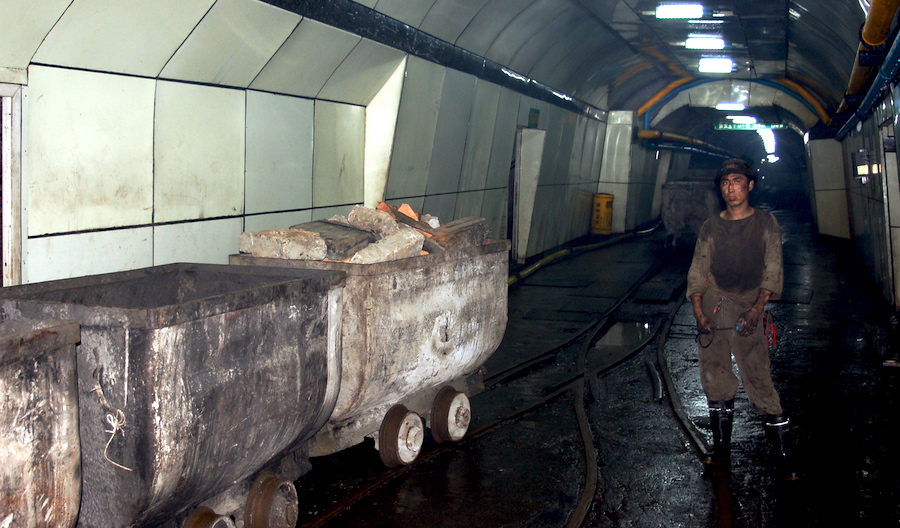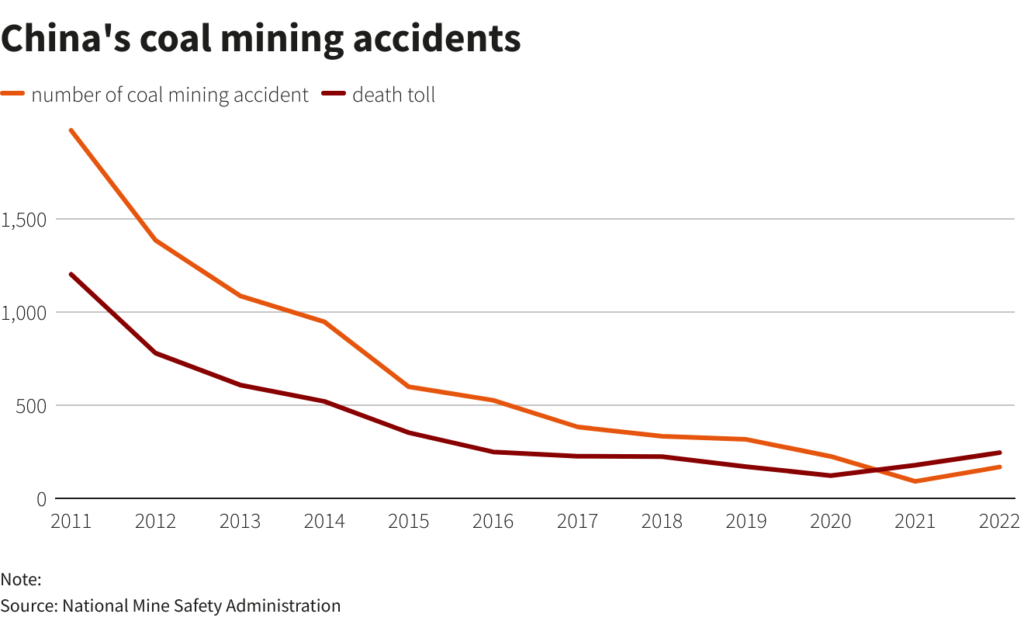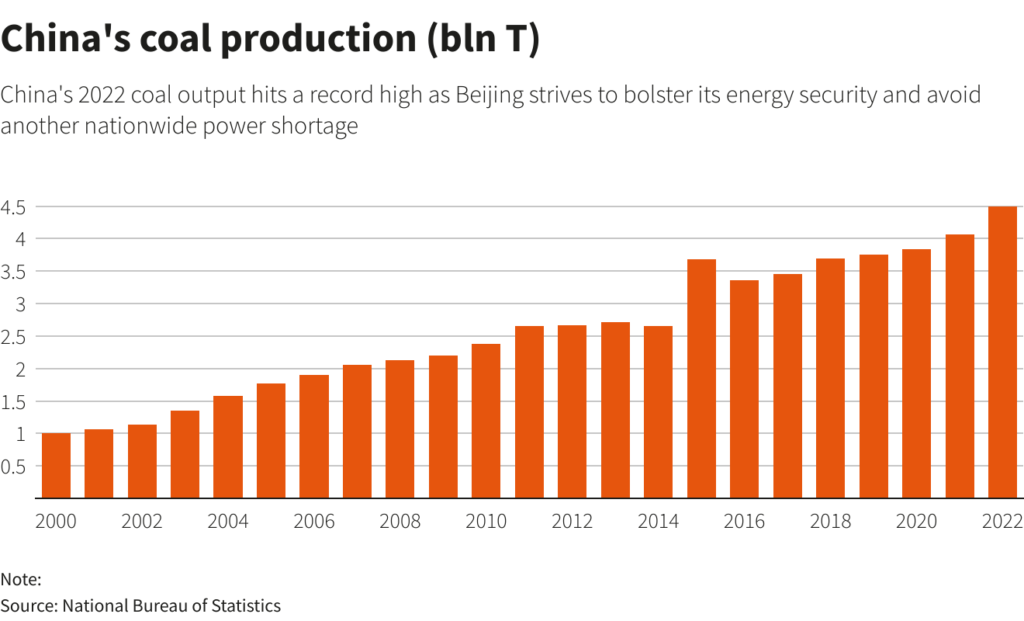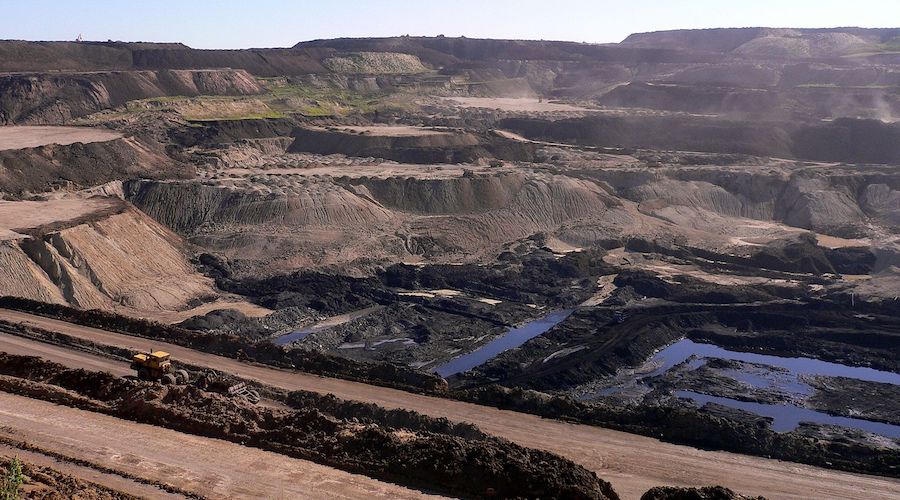Reuters | February 24, 2023 |

Coal miner in Xingtai, China. (Image courtesy of Wikimedia Commons.)
A deadly coal mining collapse in China this week is one of a growing number of industry accidents over the last year, government statistics show, coinciding with Beijing’s recent push for higher production to improve energy security.

At least six people were killed and 47 others are still missing two days after the dramatic collapse of an open pit coal mine in China’s northern region of Inner Mongolia, its No. 2 coal producing province.
The reasons for the collapse are still not known, and the mine owner could not be reached by Reuters.
The National Mine Safety Administration (NMSA) did not immediately respond to a request for comment on the accident.
But it comes after NMSA statistics released this month showed the number of accidents at coal mines almost doubled in 2022 compared to 2021 and the death toll reached a six-year high of 245, just after China called for higher coal output.

Already the world’s biggest coal producer and consumer, China increased its coal output last year by 9% to a record 4.5 billion tonnes, with the country urging miners to ramp up production after a nationwide power shortage in late 2021 led to a quadrupling of domestic prices.
Soaring global coal prices and energy supply disruption in the wake of Russia’s invasion of Ukraine also prompted Beijing to improve its energy security.
Though its mines are known to be among the deadliest in the world, accidents and deaths had been falling steadily in the decade to 2021 after China shut down excess mining capacity, reduced coal burning and strengthened safety checks.
In 2022, however, there were 168 accidents of varying degrees of severity, data from the NMSA shows, surging from 91 the year before.
In a review of the 2021 accidents, the NMSA said some coal mines were putting more emphasis on profits than safety.
“They ignored safety requirements and rushed to meet the production targets… and even violated operations regulations to run over their designed capacity,” the regulator added.
The open-pit mine that collapsed this week had been closed for three years until April 2021, state media reported. It reopened just as coal prices soared, reaching record levels later that year.
Local mine safety regulators ordered coal mines in Inner Mongolia to carry out safety checks after the accident this week.
Digging deeper
China amended its criminal law in 2021 to include punishments of managers at mines involved in accidents due to over-production.
But the NMSA also said in late 2021 that it would not engage in blind punitive production suspensions at coal mines and would instead send inspectors to help rectify problems and resume output.
With the depletion of shallow coal resources in China, coal miners are also being forced to dig deeper, posing bigger safety risks, according to experts.
“China is mining at a rate of 10 to 25 metres (33 to 82 feet) deeper each year, leaving miners facing more complicated scientific and technical problems,” Yuan Liang, a coal mining professor at Anhui University of Science and Technology, said in a research paper published in January.
China last year approved some 260 million tonnes of new mining capacity and reopened scores of mothballed mines.

Coal production is expected to further increase this year as more newly-approved mines begin operations. Shanxi and Inner Mongolia, China’s top two mining hubs by production, have vowed to lift output up by at least 5% and 2% this year, respectively.
“Improving mining safety is like pushing a boulder up a hill and involves many hurdles,” the NMSA said in a statement last month. “We will have to ensure both supply and safety.”
(By Muyu Xu and Beijing newsroom; Editing by Dominique Patton and Jamie Freed)
Death toll rises after coal mine collapses in northern China
Bloomberg News | February 23, 2023 |

Coal mine in Hailar, Inner Mongolia, China.
Bloomberg News | February 23, 2023 |

Coal mine in Hailar, Inner Mongolia, China.
(Reference image by Herry Lawford, Wikimedia Commons)
The collapse of a coal mine in northern China has claimed four lives with 49 people still missing, state broadcaster CCTV reported Thursday.

Police are investigating the cause of the disaster at the open pit operation in Inner Mongolia and have detained people suspected for being responsible, CCTV said. Six people have been rescued so far after Wednesday’s collapse, in what could prove to be the deadliest mining accident in China in years.
Sun Shaocheng, the top official in the autonomous region, said regulators will roll out safety inspections across all mines in China’s second-biggest coal hub in a bid to prevent other accidents, according to a statement. Officials from the central government’s Ministry of Emergency Management have also joined the on-site rescue effort.
The severity of the incident prompted a response from President Xi Jinping, who called on Wednesday for an all-out rescue effort and probe into its causes. The accident has landed at a sensitive time on the political calendar, with the annual National People’s Congress set to begin in the capital on March 5, and safety checks may well be extended to other mining regions. China is by far the world’s biggest producer and consumer of coal.
Mining coal in China remains a dangerous business that all-too regularly causes fatalities. A spate of deadly accidents at mines in 2021 led to a nationwide safety campaign that disrupted operations and curbed the supply of China’s mainstay fuel, contributing to power crunches that crippled the economy.
The provinces of Shanxi and Shaanxi, China’s other big mining hubs, have launched safety inspections at their mines in the wake of the disaster, according to a note from Citic Futures Co. That may slow production in the first quarter, but the impact is likely to be limited as Beijing continues to prioritize producing enough coal to fuel its economic rebound, Citic said.
The collapse of a coal mine in northern China has claimed four lives with 49 people still missing, state broadcaster CCTV reported Thursday.

Police are investigating the cause of the disaster at the open pit operation in Inner Mongolia and have detained people suspected for being responsible, CCTV said. Six people have been rescued so far after Wednesday’s collapse, in what could prove to be the deadliest mining accident in China in years.
Sun Shaocheng, the top official in the autonomous region, said regulators will roll out safety inspections across all mines in China’s second-biggest coal hub in a bid to prevent other accidents, according to a statement. Officials from the central government’s Ministry of Emergency Management have also joined the on-site rescue effort.
The severity of the incident prompted a response from President Xi Jinping, who called on Wednesday for an all-out rescue effort and probe into its causes. The accident has landed at a sensitive time on the political calendar, with the annual National People’s Congress set to begin in the capital on March 5, and safety checks may well be extended to other mining regions. China is by far the world’s biggest producer and consumer of coal.
Mining coal in China remains a dangerous business that all-too regularly causes fatalities. A spate of deadly accidents at mines in 2021 led to a nationwide safety campaign that disrupted operations and curbed the supply of China’s mainstay fuel, contributing to power crunches that crippled the economy.
The provinces of Shanxi and Shaanxi, China’s other big mining hubs, have launched safety inspections at their mines in the wake of the disaster, according to a note from Citic Futures Co. That may slow production in the first quarter, but the impact is likely to be limited as Beijing continues to prioritize producing enough coal to fuel its economic rebound, Citic said.
No comments:
Post a Comment